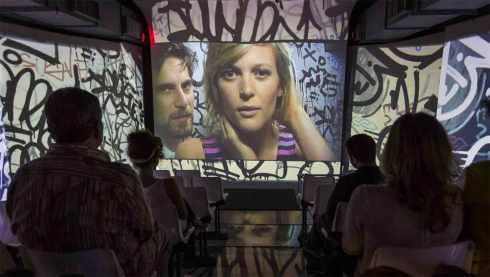Metaphor is a dramatist’s stock-in-trade, and geography, memory and nostalgia are the fabric with which he weaves his magic. The Downtown Loop, a new play written by Ben Gassman, directed by Meghan Finn, with video design by Jared Mezzocchi, takes the driving metaphor (and the metaphor of driving) as far as it can go through the streets of Manhattan, where memory and loss appear around every corner.
To make their point about geography and memory perfectly explicit, the production team created the seats to resemble the top of a double-decker bus of the kind you see lumbering through the streets of New York, crowned with tourists from distant lands who enjoy a voyeuristic lounge in the sun, peering down at you and taking your picture. Before you climb a set of stairs to take your seat, you can grab a dirty-water dog from an umbrella cart vendor (which I did) and buy a beer. Once in your seat a guide wearing a neon colored vest informs you the tour is about to begin.
The house lights go down, and the walls disappear, replaced by a panoramic view of Fifth Avenue, somewhere in Midtown. You can see forward to the Empire State Building. To your left is a department store (Bergdorf?) and to the right storefronts, pedestrians, cars. The projections used to create this illusion are brilliant, more realistic than a trip in Google Maps, and well timed to the narrative, which is supplied by our trusty narrator, a young man in his mid to late 20s with a beard, a native of Queens whose commentary on the tour is eclectic and whimsical — kind of a 21st century, hipster Holden Caulfield.
Our man Hipster Holden guides us through the streetscapes that no longer exist, layering over elements that are so present you might miss them if you blink. Where the original St. VIncent’s Hospital once stood, that neighborhood anchor on the front lines of the AIDS epidemic, contractors are planning to build outrageously expensive condos, and the sweetest homeless man who ever regaled you with stories of the time he was a Broadway dancer lies sleeping on a subway grate. By the U. N. we run into Holden’s ex-girlfriend. She’s protesting against inhumanity somewhere in the world and just started dating one of those annoying, socially-conscious Wall St. types.
Along the way Holden hooks up with a couple of European tourists, and his ex becomes progressively less progressive. By the end of the play she shows up dressed in very expensive clothes with a very, very expensive rock on her finger. The only thing constant is change, says the Buddha. That doesn’t make it any less painful though.
“What is the city but the people?” It seems as though New York’s residents, permanent, transiet, native, immigrant, rich and poor, as well as their city, have become too unbelievably rich, too unimaginatively different, too far off the script. They have erased what appeared to be their essence, but what was, in retrospect, merely the baseless fabric of this vision called The Big Apple.
I would say this is a tragic story, but, funny enough, it happens to everyone lucky enough to live to adulthood. Wordsworth and Joyce made careers pining for the lost and forgotten land of Boyhood, and even Mother Teresa sadly reflected that after a while she no longer felt the presence of the divine. The Downtown Loop is a perfect vehicle (pun intended) for New York’s 21st century crisis of conscience, its nostalgia for the “bad old days,” and its subconscious fear of that which globalization hath wrought. Catch it now, because unlike the Blue Diamond Tour, this one too will disappear and leave not a wreck behind.


Leave a comment
Comments feed for this article